
EcoEducation: The Favorable Economics of Solving the Climate Challenge
We had a very compelling presentation from UofM Economist, Jay Coggins showing that changing to renewable electrified energy makes economic sense as much as it makes environmental sense. Jay believes that we need to move to a 100% electric energy model with 100% of that electricity produced from wind, solar, hydro and geothermal. In 2018 these four sources gave us 6% of our electricity. He points out that this won't be an easy transition -- but it is the one that makes the most economic sense.
A reason that making the transition to a 100% electric energy model fueled by renewables will be economically cheaper than staying the course with fossil fuel based energy is that the world population continues to climb in numbers as well as climb out of poverty. Increasingly areas of the world that previously did not have power will have access to electric light, vehicles, and refrigeration. That increase in consumption is what will make staying the course especially expensive in terms of dollars. Right now solar and wind are the cheapest sources of energy and that includes building the infrastructure for energy capture. The same cannot be said about new fossil fuel consuming plants. To support the increased demand for energy that will come with increased population, renewables are the least expensive option.
Jay showed us an analysis completed by CitiGroup that estimates that over the next 25 years moving to 100% renewable electricity will cost the world 2 trillion dollars less than staying the course with fossil fuels. Another study completed by the International Energy Agency showed that while staying the course over the next 50 years will save about 40 trillion dollars in capital investment, the cost of the energy itself will be 115 trillion dollars more than transitioning to renewables -- so transitioning to renewables in this analysis saves 75 trillion dollars.
Bringing it close to home and focusing on Minnesota, Jay shows that by doing to work (not easy work) to change to 100% electric energy (including cars and residential heating), the average Minnesotan will save $612 per year on their energy costs.
To be able to achieve this transition there needs to be advancement in the equipment that currently operate using fossil fuels. There are examples of progress moving to electrification in almost every current use case of fossil fuels. There are heavy machinery (think huge construction trucks and tractors) that have been proven effective with hydrogen gas fuel cells. There are semi trucks built with fuel cells or batteries. We all know that personal use electric cars are viable in market. Air travel and ocean transport will be the hardest to tackle, but Jay indicates that the world is getting closer. Example there are hybrid planes in existence right now that use jet fuel for take off and landing, but use battery power for the flight itself.
Areas that will need upfront investment - storage and distribution - are also showing advances. Right here in Ramsey, MN, there is a solar field with enormous battery storage and in last year's polar vortex, the batteries filled completely even at 30 degrees below zero and then discharged to residents overnight and repeated the process day after day.
Finally, Jay shared an analysis that shows that over the next several years Xcel Energy will be able to provide 93% of electricity using solar and wind without increasing costs. Why would we object to working to reach 93% decarbonisation if there is zero cost increase? Focusing on the cost of the last 7% is a classic "cut off your nose to spite your face" tactic.
